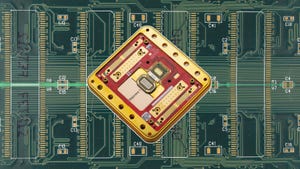Can Windows Server Make Hyper-Converged Infrastructure a Boring Commodity?Can Windows Server Make Hyper-Converged Infrastructure a Boring Commodity?
August 15, 2017

When you hear about hyper-converged infrastructure, the conversation usually has to do with a handful of specialized startups or a couple of large hardware vendors that have placed big bets on the concept. But hyper-convergence, at its core, is enabled by software, not hardware design; as such, the market is open to entry by software makers, from tiny startups to the world’s largest producer of software: Microsoft.
Windows Server 16, the latest version of the giant’s ubiquitous data center OS, includes all the elements required for hyper-convergence, which means you will probably see hyper-converged systems in data centers that haven’t necessarily bought a Nutanix box, a Dell EMC VxRail appliance, or another one of the options traditionally associated with the expression.
“Microsoft has been absent in that environment (the hyper-converged infrastructure space), but from a technology standpoint their underpinnings are extraordinarily good,” Richard Fichera, a VP at Forrester Research, told Data Center Knowledge.
But that may soon change. The software maker is actively working with numerous enterprise data center vendors on bringing a variety of hyper-converged systems to market powered by Window Server 16.
One example is Storage Spaces Direct, a software-defined storage feature in Windows Server 16, which turns standard servers with local storage into enterprise-grade storage infrastructure.
“Storage Spaces Direct is an extremely good product,” Fichera said. “It’s got tons of the right kind of features.” And it’s been battle-tested on one of the world’s largest hyper-scale clouds.
“It’s quietly being used as part of the runtime of Azure for quite a while,” Fichera said about Storage Spaces Direct. “It’s rock-solid, production-proven at scale, but Microsoft has not aggressively marketed hyper-converged solutions as a standalone product.”
Companies are interested in hyper-converged infrastructure because of the simplicity, flexibility, and low operating costs it promises. Transparency Market Research puts the technology’s global market value at $31 billion by 2025 (up from $1.5 billion in 2016), and it’s the biggest growth area for server vendors. It’s no longer considered good only for a few specific workloads, and its suitability isn’t limited to large enterprise data centers.
Over the last few years, hyper-converged has gone from an “esoteric niche focused initially on VDI” to something much more mainstream, as vendors have improved the maturity and scalability of their solutions, Fichera said. “Hyperconverged answers some really significant operational problems like the cost of storage management and ease of provisioning.” Half of Forrester’s clients report that they’re running an enterprise app or database on a hyperconverged platform – but despite the fact that it includes the kind of software-defined networking, storage, and compute you need for hyper-converged systems Windows Server hasn’t been viewed as a player in this market.
It’s There, But It’s Not Easy
One reason the OS doesn’t yet play a bigger role in hyper-convergence today is the complexity of building and configuring Windows Server-based systems with the right mix of components, from motherboards with TPMs, to NVMe drives, RDMA NICs, NVDIMMs, and upcoming storage-class memory.
The new Windows Server Software-Defined (WSSD) program is intended to simplify those decisions by offering validated combinations of hardware for specific scenarios, which have been through intensive failure simulations and come with deployment scripts and support to automatically integrate them with your infrastructure and management tools, including System Center.
“The cost saving and the consolidation of compute, network, and storage into one node is very enticing — especially if you’re looking at refreshing your infrastructure with remote storage and different network switches,” Siddhartha Roy, principal group program manager for high availability and storage in Windows Server, told us. “We are seeing ‘software-defined’ in general creating a lot of pull.”
But the industry “has got a little head of itself,” he said, with hyper-convergence seen as something anybody can do, when in reality it’s not that simple. “We found that it’s critical to have the right guard rails in many areas. The customer should not have to go through the same integration challenges and rediscover the pains that we already figured out in our integration and validation.”
Pre-Configured and Stress-Tested
WSSD systems are a collaboration between Microsoft and hardware vendors, turning the reference architecture that the Windows Server team comes up with into a hardware configuration to suit specific workloads. “We cover everything from capacity-optimized systems for archival and backup to multipurpose, to performance-optimised with really low latency,” Roy explained. “What is the right hard drive to SSD ratio? What type of data residency or what type of networking should I have? Do I need RDMA?”
There are extra tests for the NICs to make sure they support the full range of software-defined networking; then a reference build of the full configuration has to pass a 96-hour run-down test that simulates failures, explained Subodh Bhargava, who runs the WSSD program. “We simulate a private cloud environment and compress a year of data center activity: all the error conditions and edge cases plus daily tasks like doing a backup and live migrating VMs, pulling out power cords, pulling cables, a NIC failing, a hard drive failing.”
You use your own Windows Server licences for WSSD, but the solutions also include a deployment service, either from the vendor or with automated scripts. “We want to make sure the customer is not left stranded trying to figure it out themselves,” said Bhargava. “We don’t want to leave them asking, how do I deploy this on my site? How do I rack and cable this? How do I bring a network switch into this environment and configure it?” The scripts “start with bare metal, all the way up to creating the cluster, creating the software-defined storage, and software-defined network, the entire stack, and also bringing in System Center.”
Not Only for Large Enterprises
Interest in hyper-converged systems isn’t restricted to large enterprises, says Roy. “We see it reaching all the way from branch to workgroups and departments, to private enterprise ‘cloud’ where the objective is to host traditional VMs. It starts with departmental or workgroup and even regional branch offices. You have some entry-level storage or a SAN, and your SAN is getting to end of life, and probably your compute is too, and there’s opportunity to refresh both and consolidate both.”
Retail sites are also looking at hyper-converged infrastructure. “For point of sale, in each store they need a little local compute and storage, and today that’s usually a home-grown system that was put together locally that’s not standardized across stores. We see a lot of interest in getting a two-node system with shared-nothing storage that’s self-managed.”
Multiple Flavors Available
To cover that range of customers there are standard and premium hyper-converged infrastructure WSSD solutions, as well as storage-only options. “Standard is for a customer who’s looking for smaller footprint,” Bhargava told us. “They’re going from a traditional disaggregated SAN or NAS and Hyper-V hosts or a Hyper-V cluster to something collapsed into one node. That not only reduces their data center footprint, with cooling and power, but it also helps them scale out instead of up.
“The way to scale up today is that you typically scale up your Hyper-V host on the compute side, and for storage you’re adding more storage controllers or arrays. That is inherently cumbersome; customers aren’t always able to do it, and it is difficult to size that environment. What hyper-converged infrastructure does for you is allow you to scale out in this easy form factor. You can start with three or four nodes and add one node at a time and scale out compute, storage, and network all at the same time. It’s very good for customers who don’t want go through that hassle of managing the infrastructure.”
Premium systems add load balancing, software-defined networking, and secure virtualization with shielded VMs. “That allows an enterprise customer to build almost an enterprise cloud using hyper-converged deployments to serve line of businesses and create a secure multitenant infrastructure.”
The storage-only systems are for customers that just want the cost savings and performance of software-defined storage without having to spec out the hardware that will deliver the right performance and future-proof the system. “As well as going from a high-touch SAN or NAS environment to a very low-touch software-defined environment and having that flexibility, one of the key benefits of software-defined is that you can ride the industry curve. As new technologies come along, like persistent memory, like RDMA NICs, like faster motherboards, you can simply take advantage of them.”
Vendors Taking WSSD to Market
Initially, six vendors are offering WSSD systems: DataON, Fujitsu, Hewlett Packard Enterprise, Lenovo, QCT, and SuperMicro, with more joining the program later this year. These aren’t the largest hyper-converged platforms, Fichera noted, but he expects to see more vendors supporting the program in time.
“Technically [Windows Server 2016] is extremely capable and creating a structure around which the community can nucleate means we should see some growth and awareness. When Microsoft officially puts its stamp on something, it usually has an impact.”
About the Author
You May Also Like







